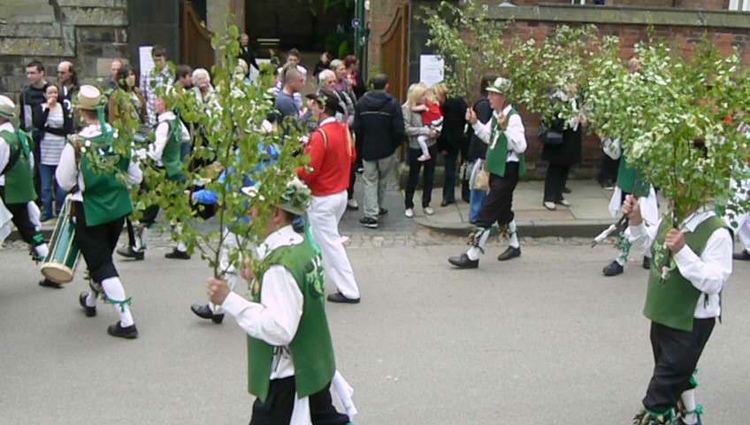 | ||
Similar Beacon Park, Erasmus Darwin House, Lichfield Garrick Theatre, Samuel Johnson Birthplac, Lichfield Cathedral | ||
Lichfield bower june 2012
The Bower is well known in Lichfield, England and nearby areas. It is a festival held each spring on a bank holiday. It is about 800 years old. A statute of Henry II of England (1134-1159) ordered that all men capable of bearing arms should be inspected by the magistrates. Since there was no standing army, this was a way to find out how many men could fight in a war. The men would then march through the streets and retire at a "Bower House" for roast beef and spirits. This ensured a good turn-out.
Today the Bower has many competitions such as tombolas. There are markets which sell local produce. The main attraction is a large funfair.

The Origins of the bower go back many centuries to the time of Henry II (1145-1189). At that time England had no standing army and when the King needed troops to defend the realm he had to raise them by mustering all the able bodied men between the ages of 16 and 60 throughout the kingdom.
To enable him to do this Henry set up a Commission of Arraye (an early example of quango) which had every year to submit to the king, a return of all the men-at-arms available throughout the kingdom. To do this they ordered every city and town to hold a muster of fighting men on one day in the year and to send the figures in to the Commission of Arraye. These musters were known as the Courtes of Arraye, and in Lichfield the Courte if Arraye was always held on Whit Monday.

It was held at Greenhill, where a “Bower House” was erected and decorated with laurel and lilac. Here the men-at-arms mustered before the magistrates with their arms and armour and were regaled with free beef and wine. At the end of the day the magistrates sent a return of the numbers to the Commission of Arraye in London. As an example of this, in 1604 the report of the Commission contained the following: “Leichfield Town, able men 285; armed men 150; pioneers 50; high horses 50”.
At Lichfield someone must have decided that having got all the men-at-arms together it was a pity not to do something with them, and so they were paraded around the streets of the city. They were accompanied by the Lichfield Morris dancers with drum and tabor and by people from the churches carrying figures of saints garlanded with flowers. Whitsun being as important festival of the Church: these garlanded figures were known as “posies”.
After the Reformation, the figures of saints were replaced by the tableaux representing different trades, but the term “posie” was still used to describe them.
The introduction of gunpowder led to musketeers being included in the procession. When the procession halted outside the horses of the principal citizens, the musketeers would fire a volley over the house, whereupon the principal citizen was expected to offer cakes and ale to those in the procession.
This went on all day, until late in the evening the participants staggered into the Market Place to be dismissed by the Town Clerk.
By the time of James II the country has a standing army, famous regiments such as the Coldstream and Grenadier Guards and the Royal Scots were already in existence, and it was decided that the Commission of Arraye was no longer needed. So it was abolished in 1690 and Courts of Arraye ceased to exist throughout the country – except in Lichfield where the inhabitants decided that as they enjoyed Bower Day so much they would continue to observe it. And this they have done right up to this day.
Most of the ancient features of the Bower still survive – the Court of Arraye is held in the Guildhall, when the Mayor inspects the “men-at-arms” the procession through the streets includes the Morris Dancers and military bands, and the place of the posies has been taken by the tableaux mounted on lorries and trailers. But, as in the past, the principal feature of the Bower is a jolly good day out for all.
